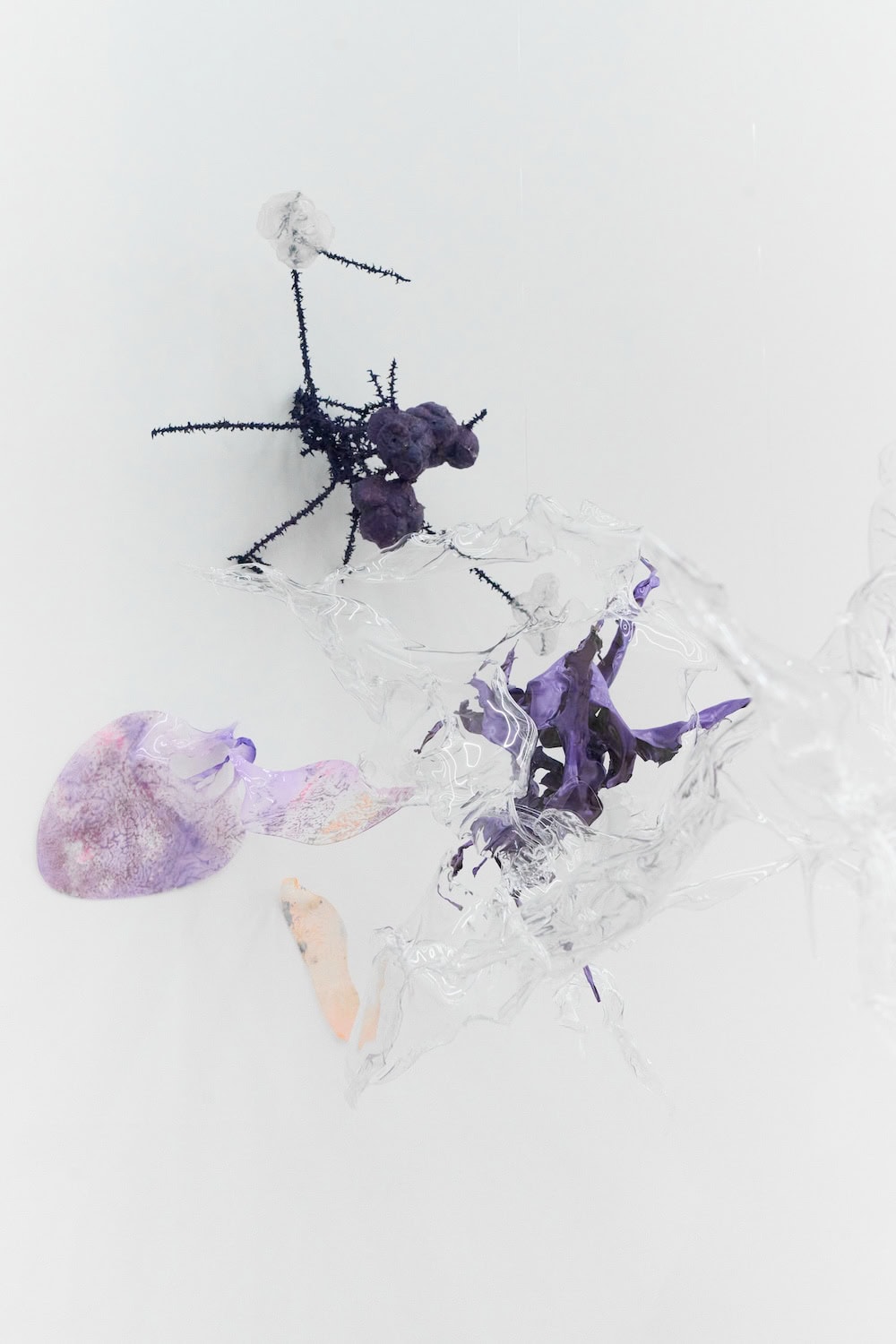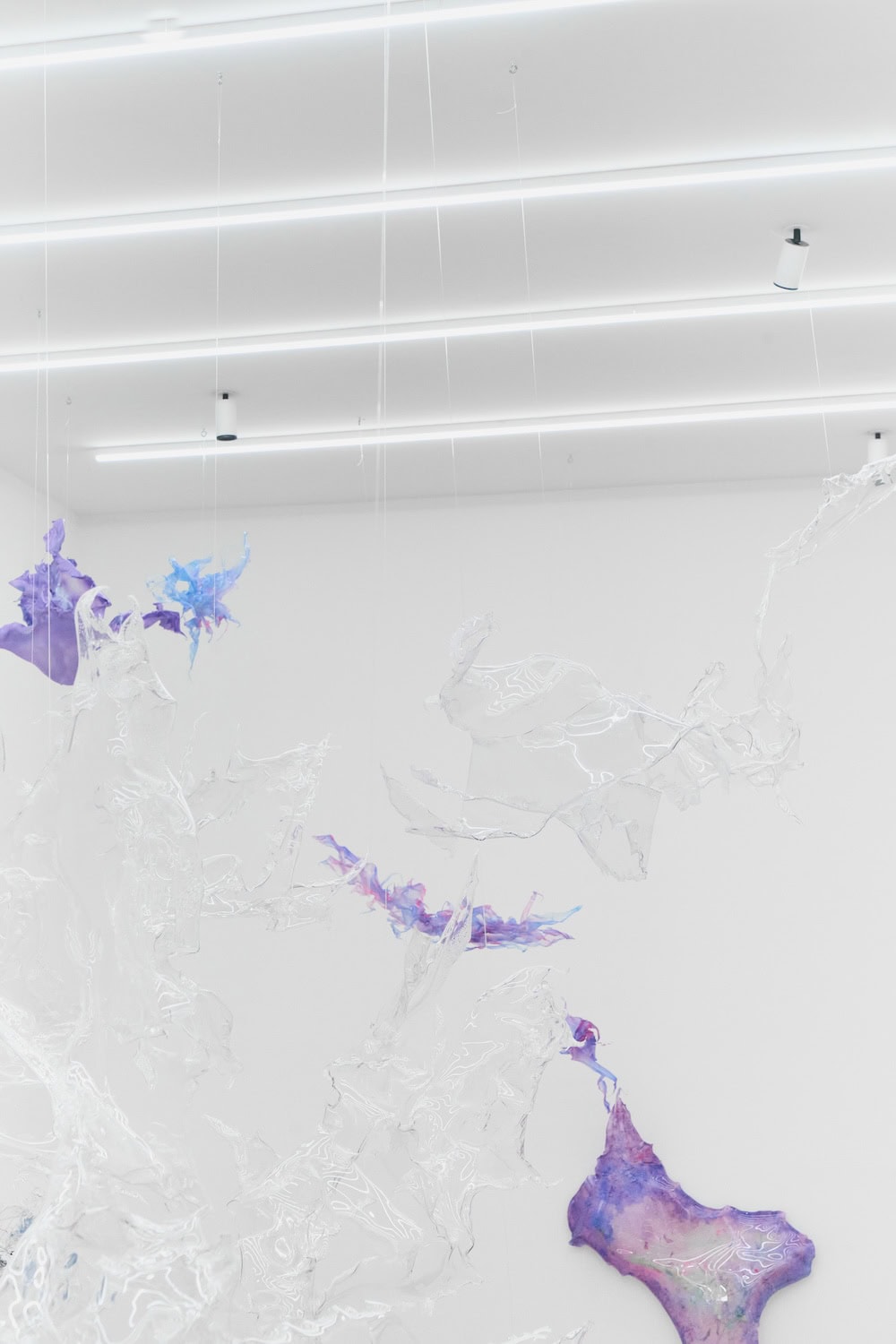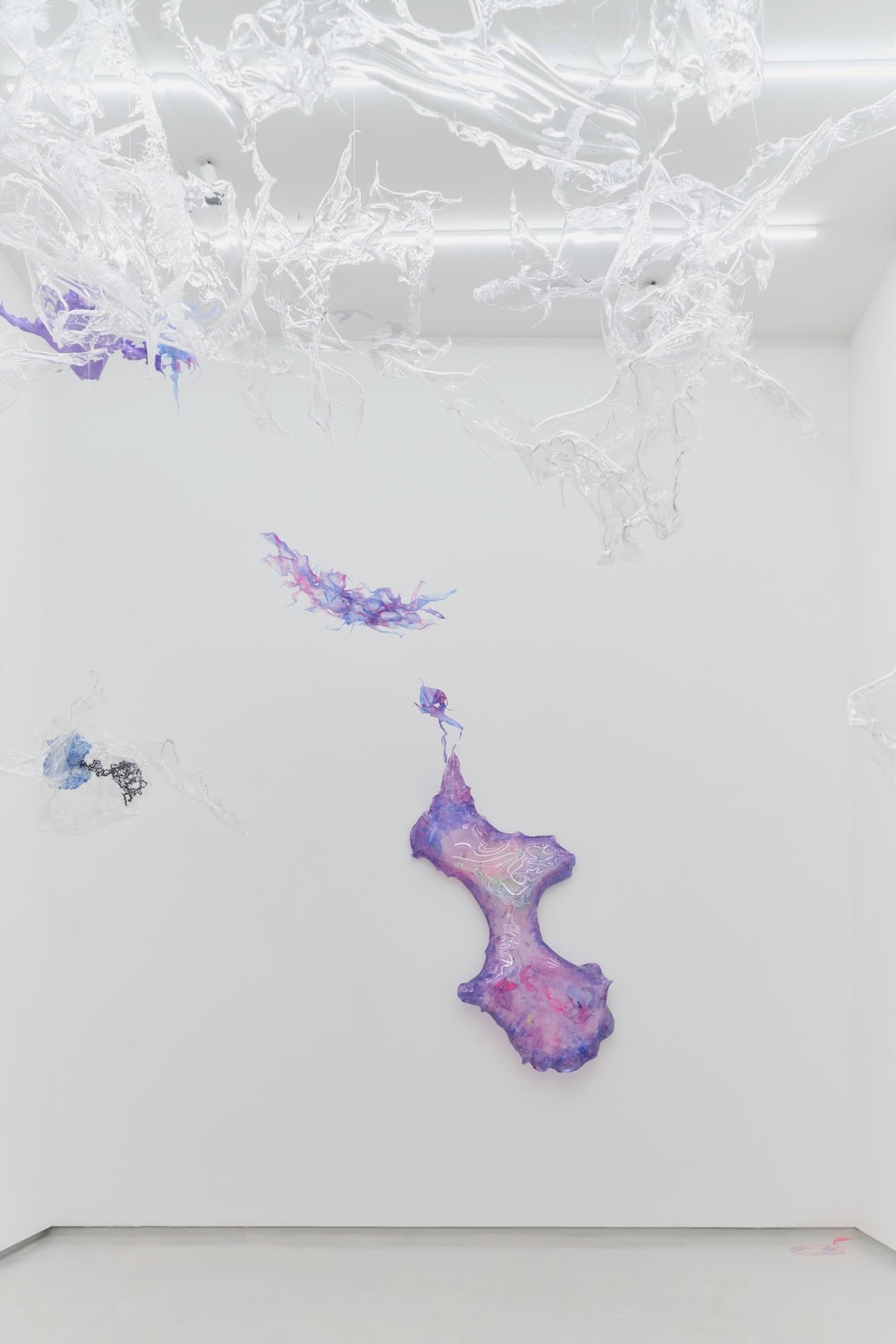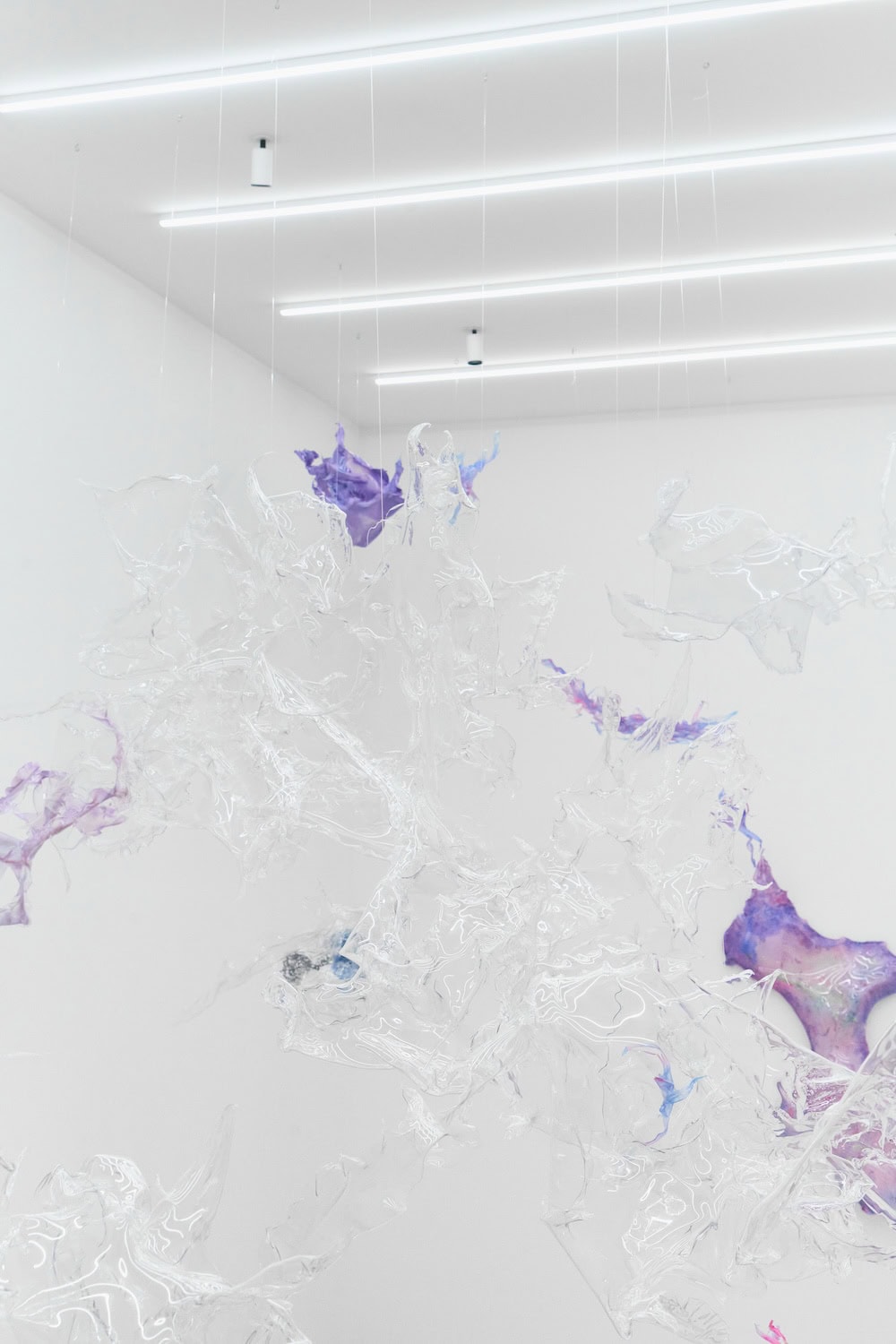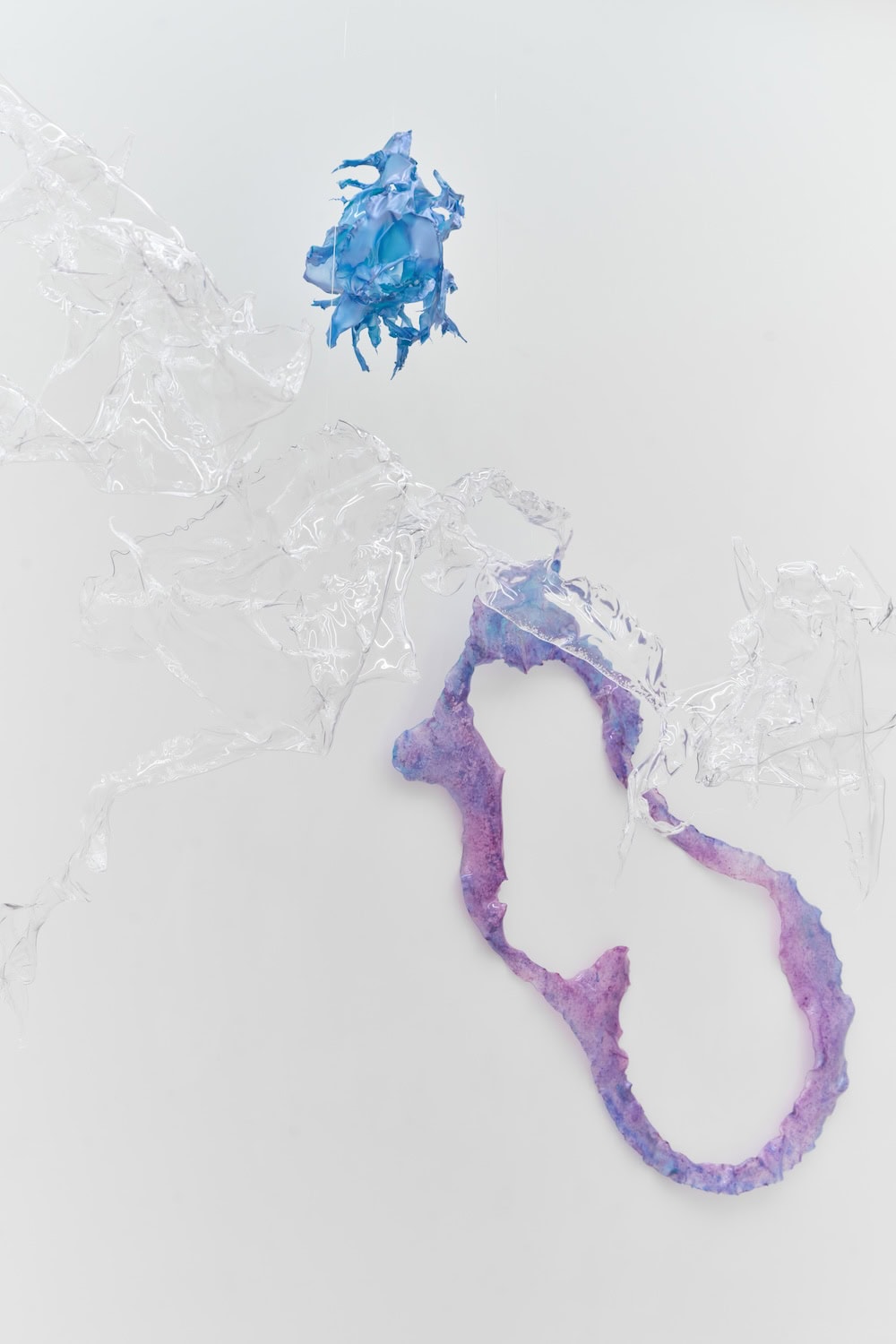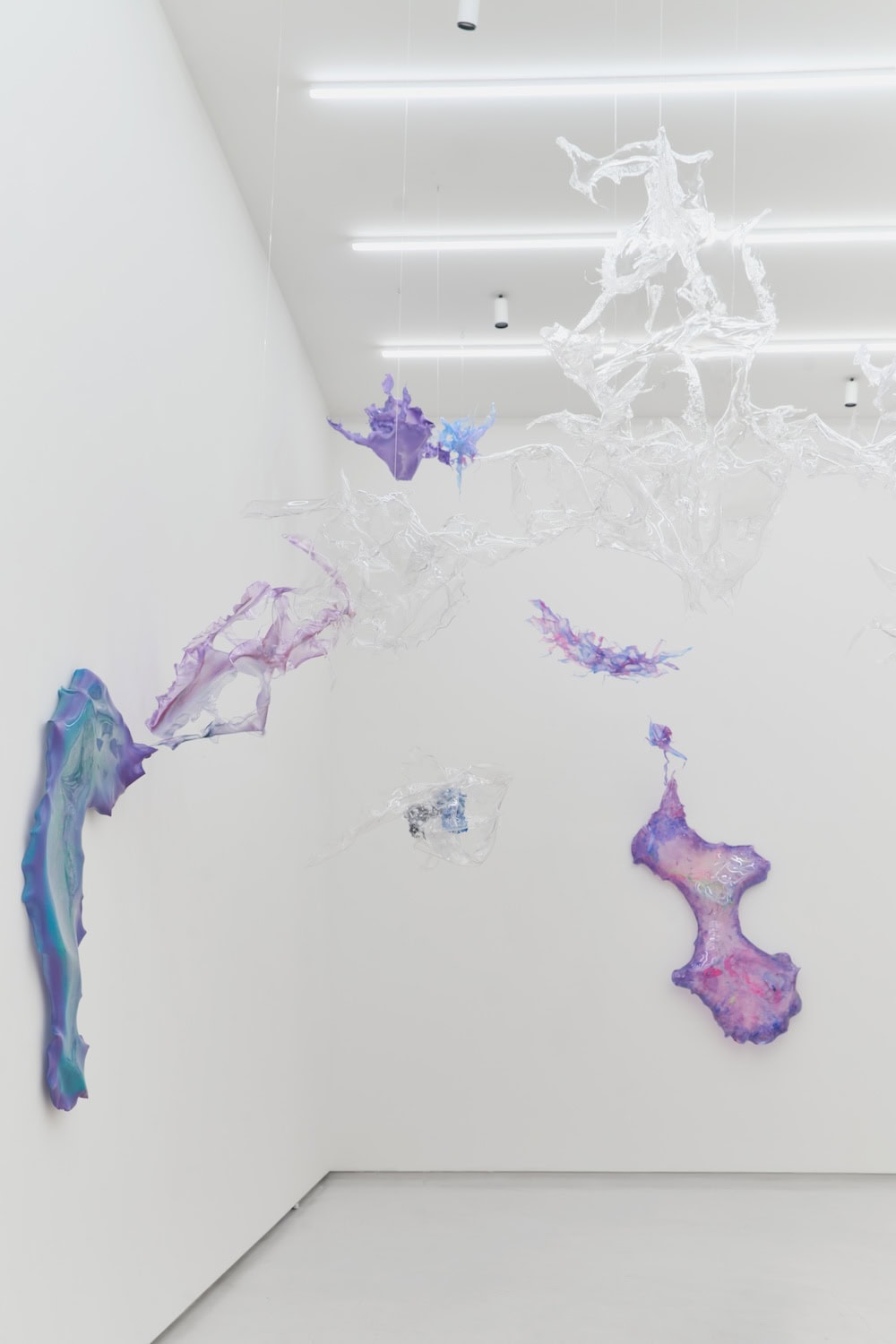Tempesta Gallery presents the bioistic installation and other biofuturistic works by Ukrainian artist Aljoscha. The exhibition, open to the public from April 11 to June 28, 2024, offers an immersion into the artist’s multiverse made of delicately coloured and translucent forms, inviting the public to reflect on eudemonism, a doctrine that considers it natural for humans to be happy and assigns human life the task of achieving it, alongside bioethics, a field of research and reflection that aims to study the complex moral, social and legal issues raised by developments in the life sciences. Aljoscha’s works are made of organic and synthetic materials, such as glass fibers and bioplastics. The multicoloured yet transparent installation extends from the ceiling in an ethereal web of weaves that encourages wonder and contemplation. Through suspended forms, Aljoscha tells a story of transitions, an evolution guided not by blind chance but by ethical wisdom. In the eclectic space of the Tempesta Gallery, distinctions between the natural and unnatural blur, inviting the audience to imagine a future in which every cell of future beings could be composed on a foundation of hope, kindness, and an enduring pursuit of understanding and acceptance. Aljoscha’s work stimulates reflection as well as debate. The implications of such ecosystem designs raise significant questions about the use of biology as a fundamental tool. And this might be precisely the artist’s goal: to provoke questions, to challenge and push toward a conversation about what our biological dystopia or dream might be.
Ilaria Sponda: Where does your work take inspiration from? How do you shape the abstract figures you place in space?
Aljoscha: I love biology and philosophy as sciences of life. What is life? How do we define it? Perhaps life is an unstoppable and fragile stream of processes; it is an ever-pulsating fountain of unknown aesthetics and sublime strangeness causing the ongoing super-mutation, which embodies the essence of beauty in its most raw and unfiltered form. Delving into the realms of biofuturism and bioism opens up a new reality where unpredictable and unknown design has an ultimate priority, composing novel life forms which redefine new life. Within this vibration of transparency and transcendence, diversity blossoms, offering endless possibilities that spark the synapses of imagination and wonder. Embracing the gentleness and fragility of life causes bliss, while the stunning interplay of happiness and harmony unfolds in ways both unspeakable and intricate.
IS: How do you see your art symbolically?
A: In my creative process, the symbolism extends far beyond mere aesthetic appeal, embodying the upcoming principles of paradise engineering and the utopia-forming quest for a new Arcadia where delight and well-being are universal and essential. Through ongoing pattern recognition imbued with philosophical reflections, my work explores the duality and paradox intrinsic to the human condition, mirroring the substance and function as theorized in the philosophy of culture. Such floating and open symbolism serve not only as an epistemological exploration but also as a justification for the transformative, mutative offsprings of thought and aesthetics that emerge from engaging with the logic of the mutations. Drawing from epigenetic influences, bioism strives for a unique ongoing re-identification with the metaphysical, transcending mere representation to reflect and recreate the complexities of existence. It is an
invitation to ponder the deep interconnections between knowledge, and logic, while forming new alien-like aesthetic desires, aligning with the ambitious aim of redefining reality into a realm of questioning and understanding. In essence, my art is a symbolic gestalt of Metamorphose that embodies the quest for a transformation, vitality, and creation of novel life forms.
IS: What feels important to translate to the public space?
A: In the public space, it feels paramount to implement the soft power of nature and the biomorphic mystery that bioengineering and synthetic biology invite us into, offering a revelation of unpredictable wonder, discovery, and fragility through the gentle and bizarre shapes of bioisms. This work fosters an exploration that surprises and sets in awe, blending the uniqueness of the individual perception with the collective trajectory towards post-humanity, where the boundaries of life definition are both questioned and expanded. It is through this synthesis of art, scientific background, and bioethical inquiry that we can recalibrate the soft whisper of nature’s resilience and its ongoing influence on the evolution of our unfolding society.
IS: What are you presenting at Tempesta Gallery?
A: Please come in person, walk through, and try to recognize the unseen. It is going to be a complex site-specific partly translucent installation, with few new experimental elements. The title of the work “Mutative Transitions into Organic Utopia” might give your imagination a good launching site.
IS: What does bioism mean?
A: Bioism is an invitation to participate in advanced evolution. Bioism is the idea of the necessity to compose, to create new life worlds from scratch, not to describe something already existing in nature. I regard each of my works as an unknown living being. Bioism extends life to lifeless subjects. Personally, I envision a future where, in the wake of a biological revolution, we will interact with living furniture, dwell in living houses, and explore space within living environments. However, the most captivating prospect lies in artists’ ability to create new living substances, thus constructing advanced, non-suffering life forms. The artistic act will acquire the practical sense of life-forming. Art museums of the future could evolve into zoological gardens, galleries into new life diversity funds, and studios into laboratories of biological complexity. Bioism aspires to disseminate new, limitless life forms throughout the universe. Bioism extends beyond abolishing suffering; it expands the horizons of consciousness and empathy. Bioism will redefine our ethical boundaries, enforce universal empathy, and actively work towards a future where suffering is minimized, well-being is maximized, and our relationship with the biological world is characterized by understanding and compassion.
IS: How does technology enter your creative process?
A: Paradoxically, the rush to technologically augment art can detract from the deeper aesthetic and conceptual creation that bioism invites. I have chosen a utopian and reflective approach, which allows for a meditative pause, prioritizing the development of an aesthetic language and conceptual framework that engages with biology without succumbing to the immediacy of technological application. Central to this somewhat idealistic stance is a firm commitment to bioethics, ensuring that the artistic exploration of life sciences is conducted with respect for the intrinsic value and dignity of all living beings. In creating installations that incorporate living organisms, my work deliberately steps away from merely interpreting nature; instead, it ventures into the spheres of the nonsensical, the non-existent, and the potentially non-functional. This cautious move towards creating bioisms that do not serve an explicit, functional purpose causes a reevaluation of our interrelations with the biosphere. It is a game, a play, which posits art as a space for existential inquiry, where the creations are not bound by the constraints of current reality or functionality, but rather, serve as catalysts for reflection on the possibilities and ethics of future biotechnological terraforming on other planets etc.
IS: Can you tell me more about your creative process?
A: I just imagine things as processes, as beings. Sometimes it results in just a small delicate drawing consisting of myriads of microdots which are all meant to be interacting individuals. Sometimes it is a monumental transparent floating super-being made of acrylic glass in the cathedral or industrial space. However, the very important quality of my process is the complexity of created structures. Sometimes people describe it as a kind of hyper-structuralism.
IS: Do you ever feel limited by what you can create in a physical space?
A: Generally not, although we live and act in the physical world. It is always great to think both dually in micro- and macro-dimensions. Such an approach allows often unexpected and surprising outcomes. Seldomly the constraints of physical space might challenge my conceptual ambitions. However, these limitations serve as a fertile ground for deviation creativity, pushing me to explore new intersections between biological processes and visual dreams that transcend traditional spatial obstructions.
IS: What’s your “organic utopia”?
A: My “organic utopia” is envisioned as a biological process, not as a state or a place. In terms of bioism and biofuturism, it represents the deviation altering through paradise engineering, where happiness and well-being give a teleological sense to existence. Sometimes I perceive an “organic utopia” as a form of collective psychotherapy. Acknowledging imperfections not as flaws but as integral to our posterity, this vision thrives eudaimonia, blending wisdom, pleasure, and kindness into a holistic existence that minimises suffering and maximises hope on the goodness in homo deus.
